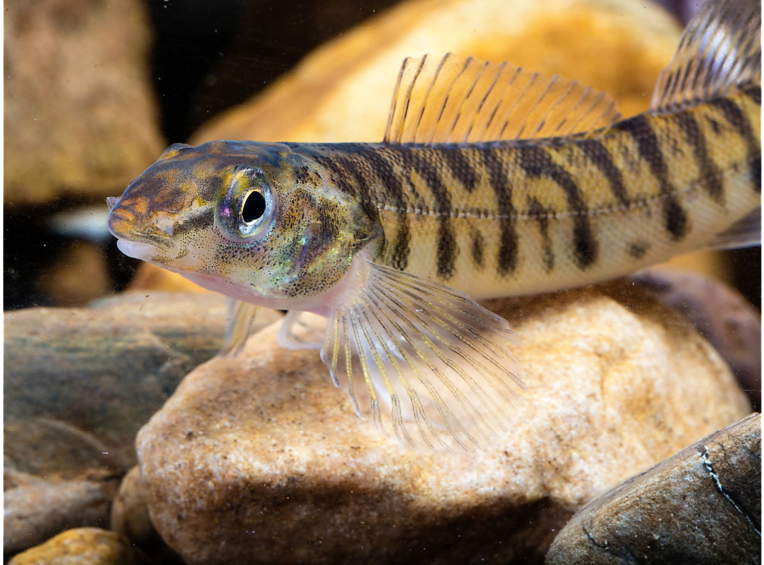Logperch Darter (photo: U.S. Fish and Wildlife Service)
Snuffbox and Logperch sound like characters in a fantasy game, or perhaps a variation of Butch Cassidy and the Sundance Kid. But they are actually a native fish and mussel species that have developed a complex interspecific relationship.
The Logperch darter (Percina caprodes) dwells on bottoms of streams and lakes, particularly those with beds consisting of sand and gravel. The logperch can be identified by its characteristic conical snout and tiger striping along the body. They prey upon aquatic invertebrates, using their snout to flip cobble and gravel to forage for food. This species ranges across much of the St. Lawrence-Great Lakes, Hudson Bay, and Mississippi River basins.
Snuffbox mussel (photo: G. Thomas Watters, Ohio State University)
The snuffbox (Epioblasma triquetra) is a small- to medium-sized freshwater mussel with a yellow, green or brown shell interrupted with green rays, blotches or chevron-shaped lines. Historically the snuffbox was widespread across 18 central U.S. states and Ontario. Today its distribution has been greatly reduced and it is currently listed as Endangered under the Endangered Species Act.
The life cycle of the snuffbox, like most freshwater mussels, is unusual and intricate. Males release sperm into the water column that is then siphoned by females to fertilize their eggs. Fertilized eggs develop into microscopic larvae, called glochidia, within special gill chambers. After brooding for up to 7 months, females expel mature glochidia, which then must attach to the gills or fins of specific host fish species to complete development into juvenile mussels. If successfully attached to a host fish, glochidia mature within a few weeks. Juvenile mussels then drop off and, if they fall onto appropriate substrate, continue to grow. Using host fish allows the snuffbox to move upstream and populate habitats it could not otherwise reach.
Snuffbox’s host is the Logperch. Foraging for food near the bottom of streams and lakes, Logperch can become entrapped by Snuffbox Mussels. The Snuffbox Mussel clamps the snout or head of the Logperch. What a first glance appears to be a defensive or predatory action is in fact the mussel’s way to release its glochidia and attach them to the gills of the Logperch for development. Once the glochidia is released, the Snuffbox mussel releases the Logperch. Demonstration of this phenomenon can be seen in the following video:
The Snuffbox mussel is sensitive to river impoundment, siltation and disturbance, due to its requirement for clean, swift current and relative immobility as an adult. In order to maintain the current populations, rivers need to be protected to reduce silt loading and run-off. Maintaining or establishing vegetated riparian buffers can aid in controlling many of the threats to mussels. Control of zebra mussels is critical to preserving native mussels. And as with all mussels, protection of their hosts habitat is also crucial. Because the life cycle of the snuffbox is inherently linked with that of the Logperch, conservation and management of this fish species is needed to insure that of the Snuffbox.
Sources: USFWS Snuffbox Mussel fact sheet; Michigan Natural Features Inventory


